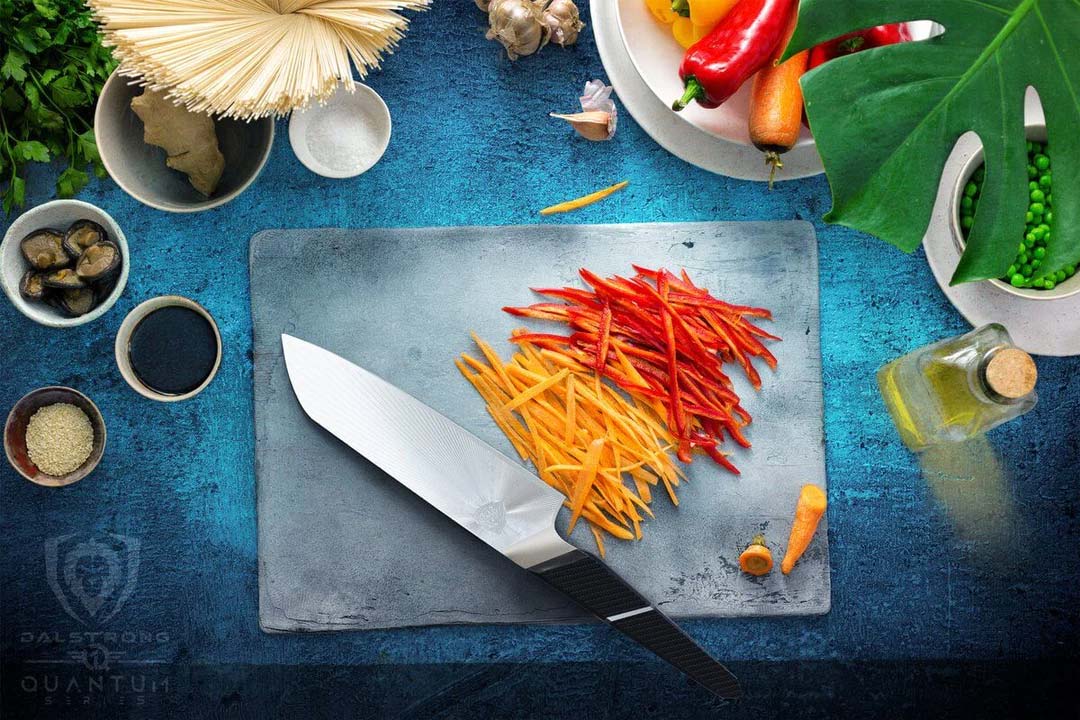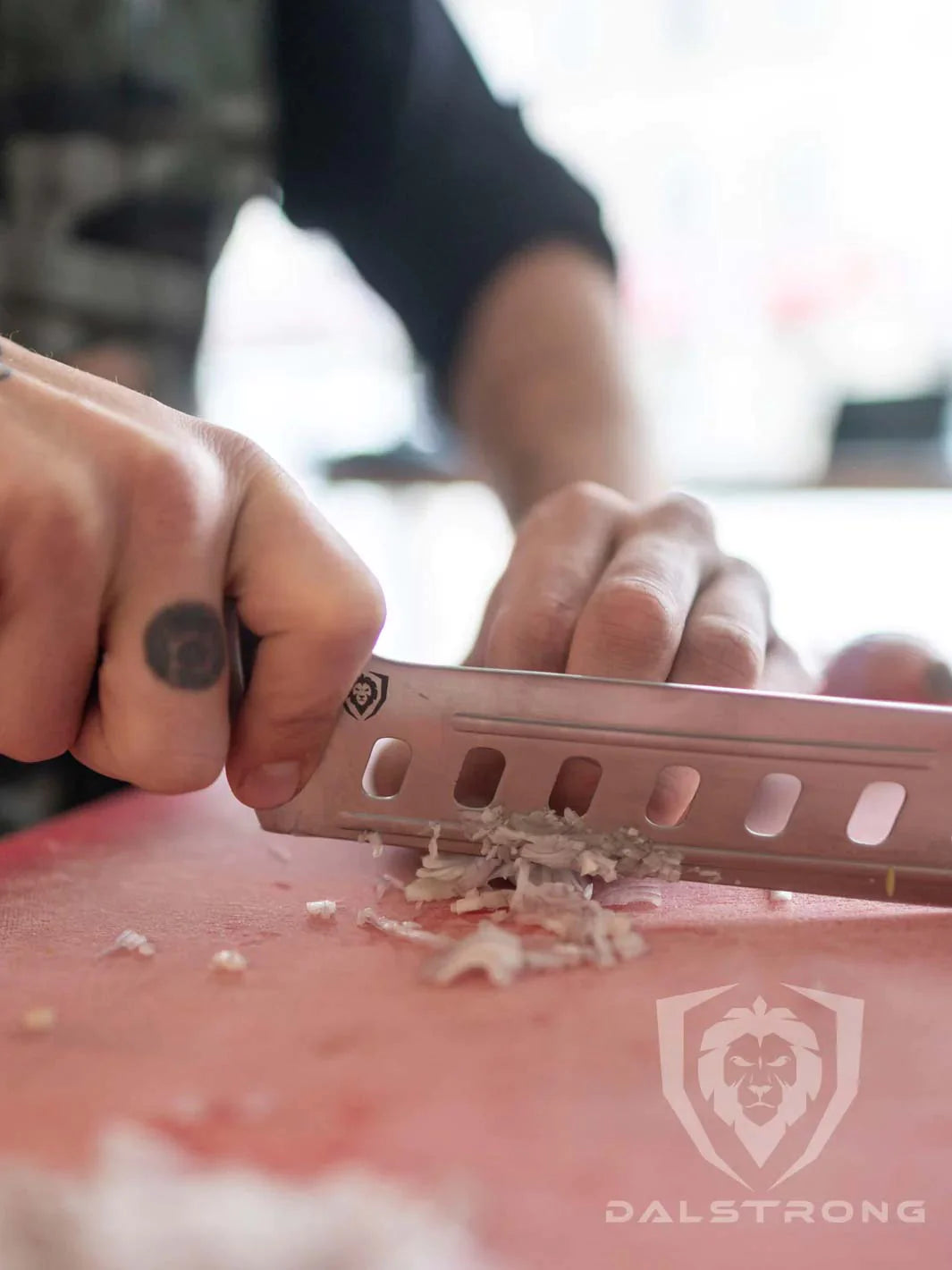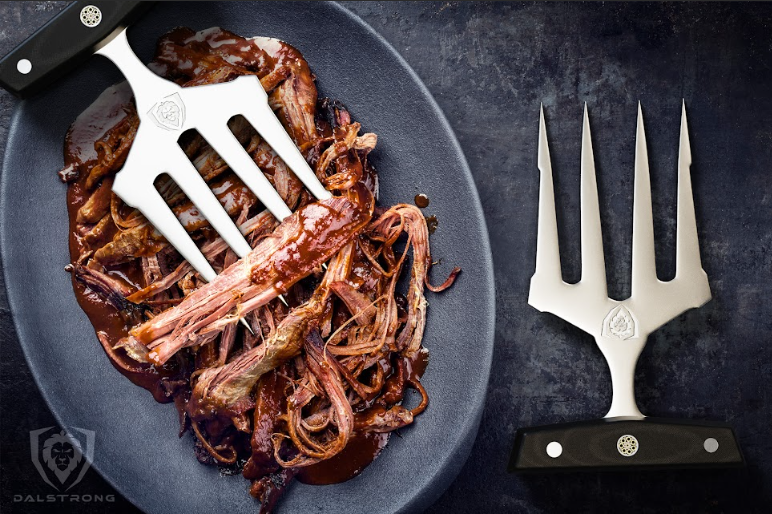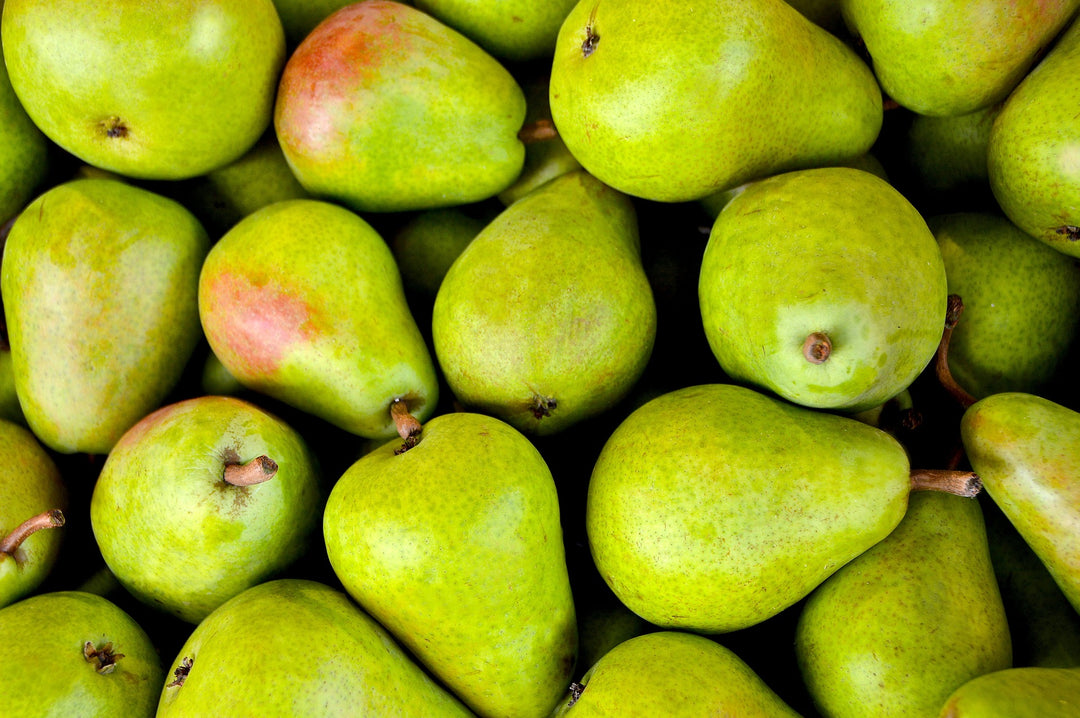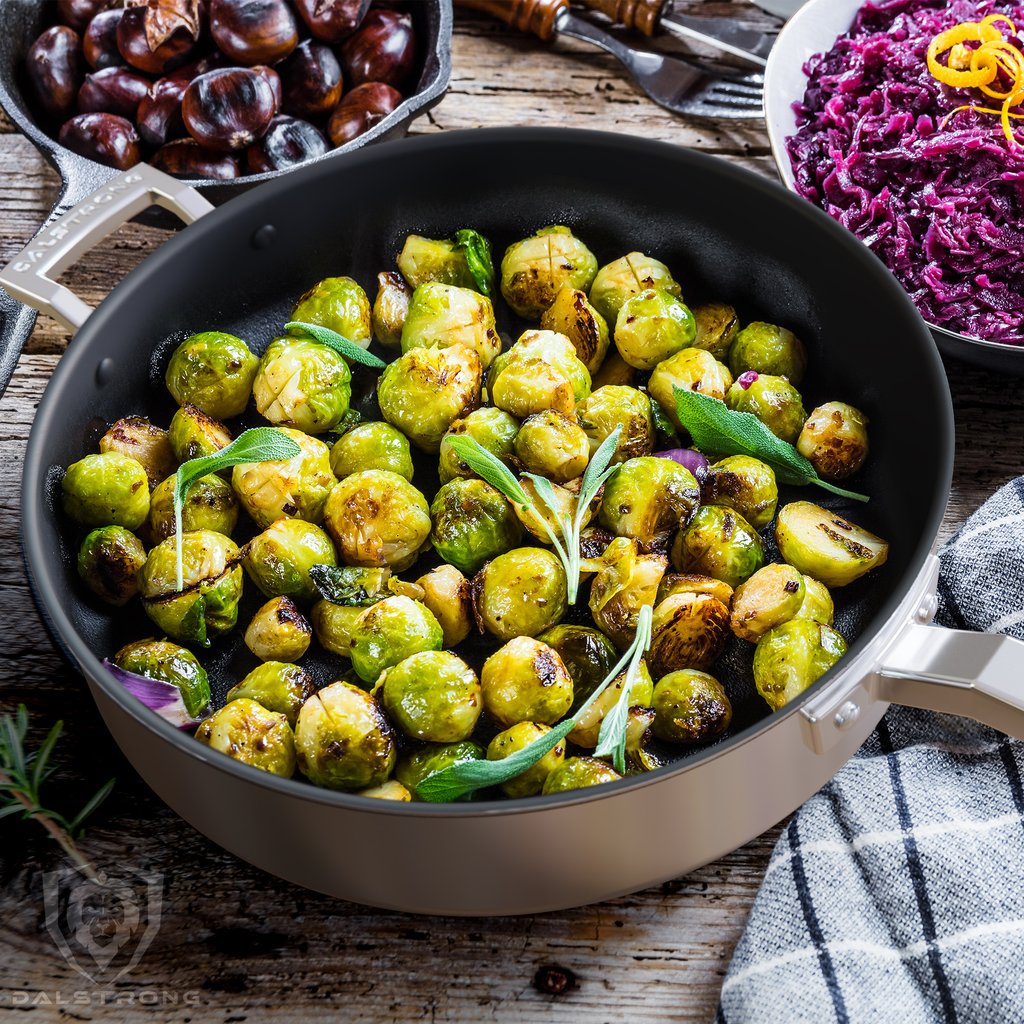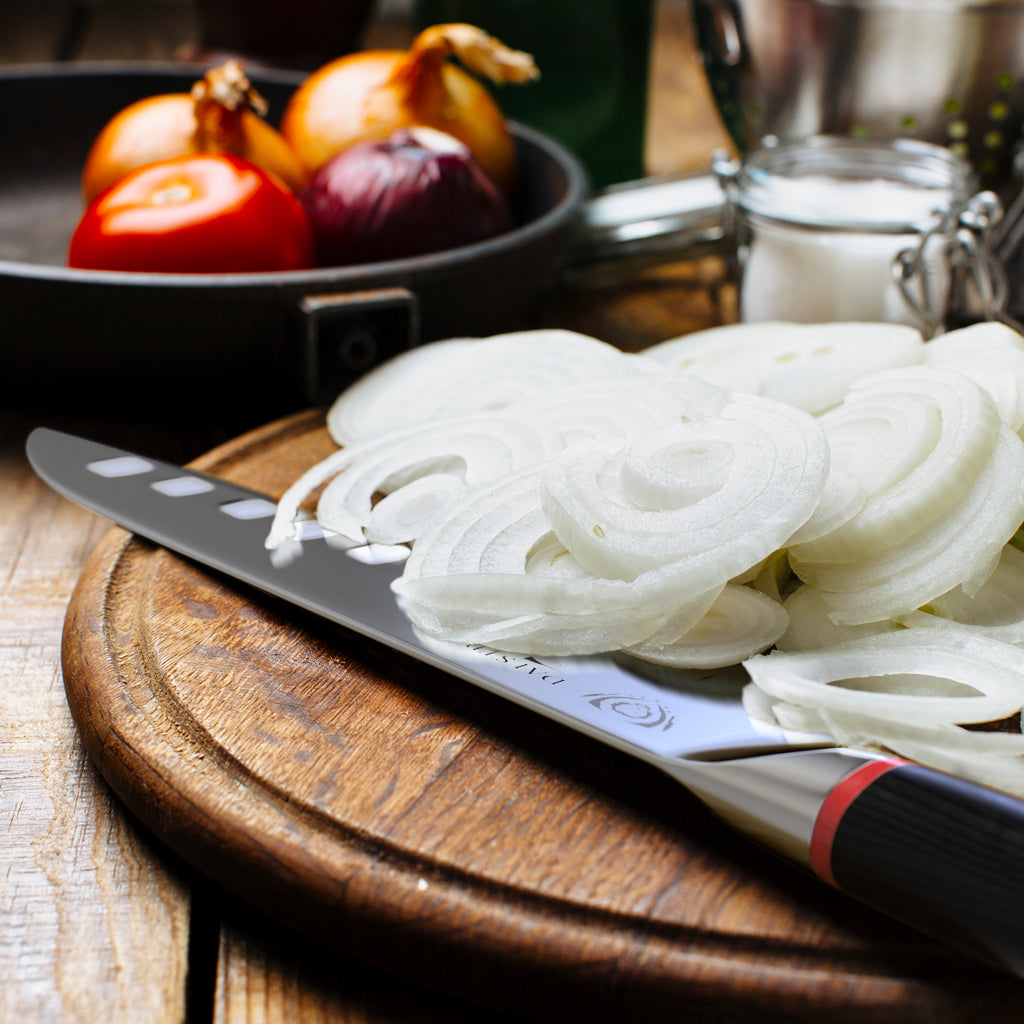The Ultimate Guide To Making The Best Paella
 12" Frying Pan & Skillet ETERNA Non-stick | Oberon Series | Dalstrong ©
12" Frying Pan & Skillet ETERNA Non-stick | Oberon Series | Dalstrong ©
Quick Overview: Easy Seafood Paella Recipe
- Steam the clams and mussels over medium-high heat. Soak the saffron in half a cup of water
- Preheat olive oil over medium-high heat. Add the prawns and cook for 6 to 8 minutes. Set aside.
- In a large wide skillet, heat olive oil and sauté the onions and garlic until fragrant.
- Add the pepper, rice, chicken broth and the saffron. Season with smoked paprika, salt and pepper to taste.
- Add the tomatoes and green beans. Cook uncovered for 10 minutes over medium-high heat.
- Uncover and place the prawns, clams and mussels over the rice, hinge sides up.
- When the rice is tender, turn up the heat at the end of cooking to get a nice crispy socarrat bottom.
- Remove the pan from the heat and cover. Garnish with fresh parsley and lemon wedges. Serve or enjoy directly from the pan as the tradition dictates.
Paella is famous for two things: one is being absolutely delicious, and the other is being difficult to cook. This is a guide to enter the exotic paella world, including a small glossary, nutritional facts, and of course: An “easy” paella recipe (sort of!)
Paella… the word is already delicious. It makes you think of a warm sunset on the coast of Spain. But it also sounds intimidating. Paella has a reputation for being a complex recipe, but it doesn’t have to be! Read on to discover the tips and tricks to this acclaimed rice dish.
1. What Is Paella?
 Chef's Knife 8"Valhalla Series | Dalstrong ©
Chef's Knife 8"Valhalla Series | Dalstrong ©
Paella, paella valenciana or 'arroz a la valenciana' is a Spanish rice dish from the Mediterranean coast of Valencia. Anyone who has visited Spain surely has been tempted to try paella.
But Paella is well-known not only in Spain, but all over the world. This well-known rice dish (originally cooked with chicken or duck, rabbit, snails, and green and white beans) has so many versions that even today, many cities claim to be the home of “the real paella”.
That’s why you’ve probably heard or tried several versions of paella. There are at least 200 dishes called "paella" with different ingredients or different proportions. There is even a version with chorizo made by chef Jamie Oliver that caused a lot of controversy among paella fundamentalists.
So, there are paellas for all tastes. And I wouldn’t dare argue which are the ingredients that make an authentic paella; but some things are non-negotiable like short grain Spanish rice, extra virgin olive oil and saffron (which gives it its characteristic yellow-orange color).
"Paella" is also the name of the pan used to prepare the dish: a large, round, flat pan with two handles (more on that later). Actually, paella is traditionally eaten from the pan itself.
2. Brief History Of Paella

The history of paella pan goes back more than a thousand years, when the Arabs introduced rice to Spain through the Mediterranean coast of Valencia.
Spanish workers seasoned rice with saffron and put it in a flat pan, covering it with vegetables and any piece of protein available at the time: rabbit, duck, beans, chicken if they were lucky. The rice was cooked in an open fire that the workers improvised with branches of orange trees (abundant in Valencia), which also gave the rice a special flavor.It is said that the first paellas also had snails, and possibly also eels. The fact is, as it often happens with ancient recipes, the original paella recipe began to develop several versions as it spread out throughout Spain.
As for the name paella, history suggests that it has to do with the word 'patella', which meant frying pan in Valencian. The original Valencian paella pan has stayed almost the same throughout the years: large, round, metal low walls and two handles.
However, a more romantic theory suggests that paella is short for ‘para ella’ (which means "for her" in Spanish) because once upon a time a boyfriend in love prepared this rice dish especially for his fiancée. A third theory attributes the name "paella" to the Arabic word "Baqiyah", meaning "leftovers".
The fact is that paella has become an exquisite international dish and a deeply rooted tradition in Spain, where paella is more of a ritual: the pan is placed at the center of the table for the whole family to share.
3. Easy Seafood Paella Recipe
 Lionswood ColossalTeak Cutting Board | Dalstrong ©
Lionswood ColossalTeak Cutting Board | Dalstrong ©
I’m going to be honest with you, there is no such thing as an “easy paella recipe”. Some recipes are simpler than others, yes. But they all need time and attention to detail. That being said, it’s also one of the most delicious and rewarding recipes you can cook for dinner, even if it’s not an “easy dinner”.
To make things easier, I have prepared this paella “glossary” with a few lesser known terms for non-Mediterranean cooks:
Paellera or paella pan. A large, shallow pan used for cooking paella or other Spanish rice-based dishes. The term derives from 'paella' the Catalan word for "frying pan".
Saffron. It is one of the most expensive spices in the world and a key ingredient in paella, giving it its characteristic yellow color.
Bomba rice. A variety of medium-grain Valencian rice widely used in dry rice dishes (such as paella) because of its low starch content. It tends to bulge when cooked, hence the name. Other types of rice used for paella are Senia and Albufera.
Socarrat. A crispy layer on the bottom of the paella pan, slightly caramelized. It is meant to be scraped off with a wooden spoon and enjoyed as part of the meal.
Sofrito. A preparation based on small pieces of tomato, onion, garlic and other vegetables, which are fried over low heat until they are reduced to a sauce that serves as a base for paella.
Chorizo. A sausage from the Iberian Peninsula made from minced meat and pork, seasoned with garlic and red pepper, which has a characteristic red color.
And now, the recipe:
Servings: 4-6
Prep Time: 20 min
Cooking Time: 60 min
Total Time: 1 hour
Ingredients:
- 8 clams, soaked and washed
- 8 mussels, washed
- 8 large prawns or shrimp, peeled and deveined
- 2 cups of Spanish paella rice (any medium grain rice will do)
- 4 cups chicken broth
- 2 large pinches of saffron
- 1 large onion, chopped
- 4 cloves garlic, crushed
- ½ green bell pepper, julienne
- ½ red bell pepper, julienne
- 2 tomatoes, chopped, skinned and seeded (or 1 cup tomato puree)
- 2 teaspoons smoked sweet paprika
- 1 cup green beans
- 2 tablespoons parsley, finely chopped
- 3 tablespoons olive oil
- Salt and pepper
- Optional: pepper flakes
- Optional: Dry white wine
- Optional: Lemon wedges for garnish
Preparation:
- Steam the clams and mussels over medium-high heat (you can add a touch of white wine to taste). When the clams and mussels have opened, it means they’re ready. This usually happens 3 minutes after boiling.
- Soak the saffron in half a cup of water for 10 minutes.
- Preheat olive oil over medium-high heat. Add the prawns and cook for 6 to 8 minutes, turning the pieces every 3 minutes until slightly pinker. Set aside.
- In a large, wide skillet (such as the 12" Sauté Frying Pan | ETERNA Non-stick | Oberon Series), heat olive oil and sauté the onions and garlic until fragrant.
- Add the pepper and the rice and stir for 3 minutes.
- Add the chicken broth and the saffron. Season with smoked paprika, salt and pepper to taste.
- Add the tomatoes and green beans. Stir softly and briefly. Shake the pan a bit, just to evenly spread the rice layer (don’t over stir!)
- Cook uncovered for 10 minutes over medium-high heat until the rice absorbs most of the liquid. Then reduce heat to the minimum, cover the pan and simmer for another 5 minutes.
- Uncover and place the prawns, clams and mussels over the rice, hinge sides up. If necessary, add a tiny bit of water if the rice is not yet cooked. Cover again and cook for another 10 minutes.
- When the rice is tender, turn up the heat at the end of cooking to get a nice crispy socarrat bottom. When you start to hear a sizzling sound, leave it to cook for another 30 seconds and turn off the heat.
- Remove the pan from the heat and cover. Let it rest for 5 to 10 minutes.
- Garnish with fresh parsley and lemon wedges. Serve or enjoy directly from the pan as the tradition dictates.
4. Tools You Will Need To Make Paella
The most important thing you’ll need to cook paella is a proper pan or skillet. Here are our recommendations:
1. 12" Sauté Frying Pan | ETERNA Non-stick | Oberon Series
The size, as well as the wide and flat base makes this versatile pan very practical for paella. But forget paella for a second: the 3-layer aluminum core ensures impeccable conductivity to quickly heat, brown, braise and evenly cook all kinds of recipes from meats and stews to frittatas and delicate omelets.
PROS:
- Premium quality aluminum to preserve the heat and protect the flavor.
- Corrosion resistance thanks to additional layers of non-reactive stainless steel.
- Premium nonstick coating, ten times more durable than other options.
- Side handle to hold and move the pan with ease and confidence.
- Thick, extra-strong tempered glass lid.
- Design that conveys luxury and elegance.
- Great price for a premium skillet with a limited lifetime warranty.
CONS:
- The more purist paella cooks will surely prefer a classic style paella pan.
- I love non-stick cookware. But it’s true that achieving that perfect “sorrocat” may be difficult on a non-stick surface.
2. 12" Sauté Frying Pan | Hammered Finish Silver | Avalon Series
The shape of this Dalstrong pan makes it possible to cook traditional paella and rice, stir-fry, meat and seafood to perfection. It heats up quickly and evenly thanks to a 5-ply copper base. Extraordinary conductivity and performance.
PROS:
- Compatible with all cooktops.
- Flat bottom for consistent cooking (and so necessary in the case of paella).
- Ultra-durable, heavy-gauge construction.
- Non-reactive 18/10 stainless steel interior and additional premium aluminum.
- Long, strong main handle and complementary side handle for easy handling.
- Beautiful hammered finish that conveys luxury and distinction.
CONS:
- Depending on the size of your kitchen, it may more convenient to get a smaller pan, like our next recommendation.
- While the sturdiness of this pan is a clear advantage in so many other cases; it is true that thinner cookware is preferred for paella.
3. 10" Frying Pan & Skillet | Hammered Finish Black | Avalon Series
This premium skillet with a copper core could work great for paella because of its sturdiness and superior heat conductivity. As a plus, the elegant black design already reminds us of a Spanish paellera and we’ll soon feel the Mediterranean spirit taking over the recipe.
PROS:
- The 5-ply copper core really stands out above the competition.
- Non-reactive stainless steel and premium aluminum coating.
- Thick enough to prevent denting or warping under prolonged heat.
- Sophisticated design in black with a hammered finish.
- Suitable for freezer and refrigerator.
CONS:
- This isn’t a non-stick frying pan (but a traditional paella pan isn’t either). You should not have a problem if you follow the recipe, though.
- The premium quality lid is made of stainless steel. Other recipes besides paella may require a little supervision through a glass lid.
4. 12" Sauté Frying Pan | Silver | Oberon Series
An affordable, practical, yet premium-quality option that clicks all the boxes for paella: wide, flat bottom, medium-weight, and impeccable conductivity. What sets it apart from other aluminum cookware is the fusion of stainless-steel layers to further enhance performance and durability.
PROS:
- A solid pan made with excellent materials, construction and finishes.
- Some say this is the perfect size for a pan.
- It heats up really quickly.
- Something worth mentioning is how easy to clean this pan is and how “non-stick” it is for a non-stick pan.
- A nice detail: the lid knob is beautiful, with a mirror polish and Dalstrong’s iconic “lion” on top.
CONS:
- The design is elegant, but simple and traditional. Some people prefer their cookware design to be more avant-garde.
- Some people have their reservations when it comes to aluminum cookware. However, this is probably among the best, safest aluminum cookware out there.
5. 10" Frying Pan & Skillet | ETERNA Non-Stick | Oberon Series
This high performance non-stick frying pan is capable of cooking a tasty paella for two or three. Like all Oberon cookware, this pan features an aluminum core and additional layers of non-reactive 18/10 stainless steel to better brown and cook any type of food.
PROS:
- Extra-thick 35-micrometer Eterna® coating, that lasts much longer than traditional nonstick coatings.
- Made of non-toxic, non-hypoallergenic materials free of PFOA and APEO.
- It can be used in the oven and on the grill and it’s compatible with all types of stoves.
- Comfortable and secure grip.
- Perfect-fitting glass lid.
CONS:
- Some cooks may need a larger capacity like the 12" Frying Pan & Skillet from the same series.
- It does not have a second side handle, as traditional paellas do. The second handle makes it easier to stir the rice.
5. Tips For Making The Best Paella

- Choose your pan right. It should be shallow, wide and medium-weight.
- Pay attention to rice, as it is the main ingredient in the paella recipe, but also the trickiest. Choose short-grain or medium-grain Valencian rice and don’t overcook it.
- For cooking paella, it’s best to use gas or induction stoves. Heat distribution is important for this recipe. However, if you use an electric stove, rotate the pan once in a while to ensure no side cooks more than the other.
- Paella doesn’t require constant stirring like risotto. If you over-stir, you may ruin your chances of getting that delicious, caramelized crust on the base (sorrocat).
- Paella shouldn’t be cooked in advance, it should be cooked and enjoyed as soon as possible. Don’t add the rice to the mix until all of your guests have arrived. Eat it warm and don’t wait too long. When you go for your second round after finishing the first plate; you’ll see how it’s already changed.
- Don’t hesitate to use a fair amount of oil. The recipe calls for it. Oil will help the sofrito spread its flavor all over the pan and also keep the rice grain separate.
- Enjoy the crust. The sorrocat is considered, by many, the best part of eating paella. Use a spoon to scrape it from the bottom!
6. Paella Nutritional Facts

The rice in paella is rich in complex carbohydrates and provides long-lasting energy. The “fat” in paella is mostly healthy, provided by olive oil. Fiber is there too thanks to the rice and vegetables. And seafood will guarantee a good protein intake.
Seafood Paella
(Estimated values based on a serving of 240 g)
- Calories: 341 kcal
- Fat: 11g
- Cholesterol: 60 mg
- Sodium: 1462 mg
- Potassium: 269 mg
- Carbohydrates: 39 mg
- Fiber: 1.9g
- Sugar: 2.2g
- Protein: 19g
7. How To Store Your Paella

Paella is a dish that is best enjoyed warm and freshly made. That is a fact, not an opinion.
Tradition dictates paella should be eaten all the way to the sorrocat and then to the bottom of the empty pan.
Once in the refrigerator, paella loses its original charm pretty quickly. The flavors may mutate, the whole thing becomes rubbery and chewy. Plus the risk of harmful bacteria growth in the rice and seafood.
However, it’s also true that paella is usually cooked in large quantities, and, being such a legendary dish, you are not going to throw away any possible leftovers. There are a few techniques to increase your chances of good leftover paella.
- Store your paella as soon as possible after it reaches room temperature. Don't wait more than two hours (or more than an hour in very hot climates).
- Leftover paella can withstand up to 2 days in the refrigerator if stored in an airtight container. Or three months in the freezer.
- If the paella contains seafood, the shells should be removed before storing the leftovers. Consider removing all the seafood if you decide to freeze leftover paella, because it usually does not freeze well. In this case it is actually best to keep it in the refrigerator and eat it within two days and no more, for food safety reasons.
- Separate the leftovers into individual servings and store them in airtight bags, but first remove as much air as possible. You can cover the top of the rice with a plastic wrap.
- When you decide to thaw the paella, transfer it to the refrigerator overnight; and if necessary, place the frozen bags in room temperature water to accelerate thawing.
8. Other Paella Recipes You Should Try

Seafood paella is my favorite, but these other versions are worth a try:
- Paella mixta or mixed paella, combining seafood and meat,
- Paella de pollo or chicken paella, one of the most popular versions,
- Paella valenciana or traditional Valencian paella. The characteristic ingredient is rabbit, also chicken, and sofrito,
- Paella with chorizo, a controversial recipe including Spanish chorizo,
- Vegetarian or vegan paella loaded with vegetables (onions, garlic, bell pepper, beans, fresh parsley…), without animal protein.
9. Frequently Added Questions About Paella
What dessert recipes go well with paella?
You can combine this Mediterranean meal with some Spanish dessert recipes like churros, sangria sorbet, flan or crema catalana.
Is there chorizo in mixed paella?
Mixed paella or “paella mixta” includes both seafood and meat. The meat in this recipe is usually chicken or chorizo.





































































































































































